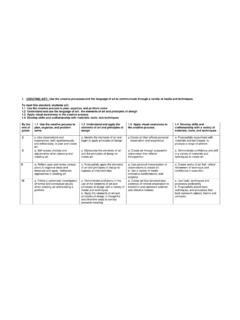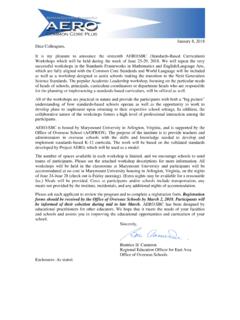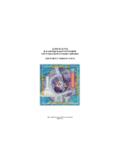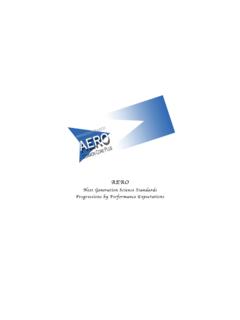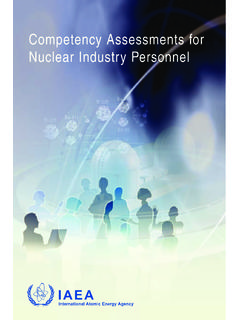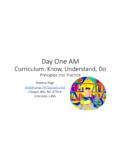Transcription of TABLE OF CONTENTS - projectaero.org
1 2 AERO MATHEMATICS FRAMEWORK AERO 2011 TABLE OF CONTENTS 4 Process 8 Problem 9 Reasoning and 12 13 15 content Standards Numbers and Operations Standard 17 Number 18 Operations on 26 31 Measurement Standard 33 Physical 34 Systems of 36 Patterns, Functions, and Algebra Standard 40 Patterns, Relations, and Function.
2 41 Algebraic .. 43 Algebraic Representation .. 46 Analysis of 47 Geometry Standard 48 Geometric 50 Transformation of 51 Coordinate 55 Visualization and Geometric 56 Data Analysis and Probability Standard 57 Data 59 Data 60 Inferences and 62 54 64 66 3 AERO MATHEMATICS FRAMEWORK AERO 2011 content Standards Numbers and Operations Patterns.
3 Functions, and Algebra Spatial Relationships , Geometry, and Logic Measurement Data Analysis Process Standards PROBLEM SOLVING MATHEMATICAL REASONING MATHEMATICAL CONNECTIONS MATHEMATICAL COMMUNICATION AND REPRESENTATION The mathematical processes provide the framework for teaching, learning, and assessing in mathematics at all grade levels . Instructional programs should be built around these processes. 4 AERO MATHEMATICS FRAMEWORK AERO 2011 AERO MATHEMATICS CURRICULUM FRAMEWORK K-8 STANDARDS AND PERFORMANCE INDICATORS Teaching Mathematics for the 21st Century We need citizens who can problem solve and think critically to compete in an ever-changing technological and global society.
4 We must produce students who are capable of becoming life-long learners and successful citizens in a global market place. Therefore, students must develop a deep understanding of mathematical concepts and possess a strong foundation of number sense in order to become proficient in mathematics. Every teacher of mathematics has an individual goal to provide students with the knowledge and understanding of the mathematics necessary to function in a world very dependent upon the application of mathematics. Instructionally, this goal translates into three components: conceptual understanding; procedural fluency; problem solving Conceptual understanding consists of those relationships constructed internally and connected to already existing ideas.
5 It involves the understanding of mathematical ideas and procedures and includes the knowledge of basic arithmetic facts. Students use conceptual understanding of mathematics when they identify and apply principles, know and apply facts and definitions, and compare and contrast related concepts. Knowledge learned with understanding provides a foundation for remembering or reconstructing mathematical facts and methods, for solving new and unfamiliar problems, and for generating new knowledge. Procedural fluency is the skill in carrying out procedures flexibly, accurately, efficiently, and appropriately.
6 It includes, but is not limited to, algorithms (the step-by-step routines needed to perform arithmetic operations). Although the word procedural may imply an arithmetic procedure to some, it also refers to being fluent with procedures from other branches of mathematics, such as measuring the size of an angle using a protractor. The use of calculators need not threaten the development of students computational skills. On the contrary, calculators can enhance both understanding and computing if used properly and effectively.
7 Accuracy and efficiency with procedures are important, but they should be developed through understanding. When students learn procedures through understanding, they are more likely to remember the procedures and less likely to make common computational errors. Problem solving is the ability to formulate, represent, and solve mathematical problems. Problems generally fall into three types: one-step problems multi-step problems process problems Most problems that students will encounter in the real world are multi-step or process problems.
8 Solution of these problems involves the integration of conceptual understanding and procedural knowledge. Students need to have a broad range of strategies upon which to draw. Selection of a strategy for finding the solution to a problem is often the most difficult part of the solution. Therefore, mathematics instruction must include the teaching of many strategies to empower all students to become successful problem solvers. A concept or procedure in itself is not useful in problem solving unless one recognizes when and where to use it as well as when and where it does not apply.
9 Therefore, students need to be able to have a general understanding of how to analyze a problem and how to choose the most useful strategy for solving the problem. 5 AERO MATHEMATICS FRAMEWORK AERO 2011 Individually, each of these components (conceptual understanding, procedural fluency, and problem solving) is necessary but not sufficient for a student to be mathematically proficient. They are not, however, independent of each other. They are integrally related, need to be taught simultaneously, and should be a component of every lesson.
10 In this document conceptual understanding, procedural fluency, and problem solving are represented as process strands and content strands. These strands help to define what students should know and be able to do as a result of their engagement in the study of mathematics. Process Strands: The process strands (Problem Solving, Reasoning and Proof, Communication, and Connections/ Representation) highlight ways of acquiring and using content knowledge. These process strands help to give meaning to mathematics and help students to see mathematics as a discipline rather than a set of isolated skills.
